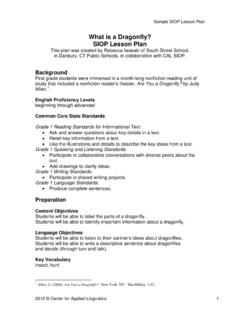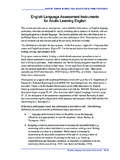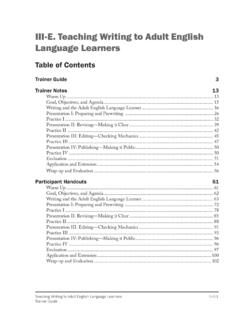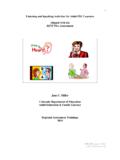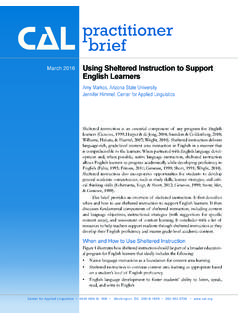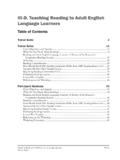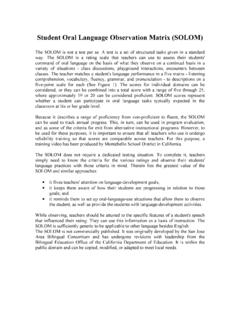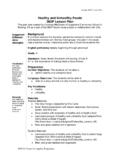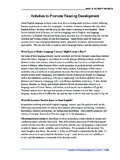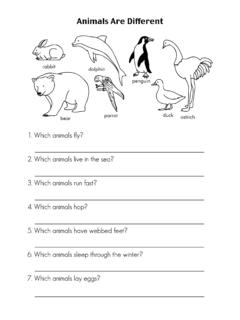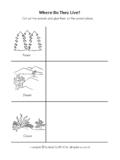Transcription of Nocturnal vs. Diurnal Animals SIOP Lesson Plan
1 Sample siop Lesson plan 2010 Center for Applied Linguistics Nocturnal vs. Diurnal Animals siop Lesson plan Background Theme: Nocturnal vs. Diurnal Animals Lesson Topic: Which Animals come out at night and which ones come out during the day? Grade: 1 Standards: State Science Standards of Learning, Grade 1, & Preparation Content Objectives Students will identify adaptations that help Animals navigate daytime and nighttime environments. Students will sort different Animals that are either Diurnal or Nocturnal Language Objectives Students will be able to discuss the differences between Animals that are active during the day and Animals that are active at night.
2 Students will write one-sentence summaries presenting key information about Nocturnal and Diurnal Animals . Students will read their summaries about Nocturnal and Diurnal Animals in front of the group. Students will apply, orally and in writing, new vocabulary words related to Nocturnal and Diurnal Animals . Learning Strategies: Using T-charts, visual aid images (photographs), and other graphic organizers; developing vocabulary through context clues; summarizing key information Key Vocabulary Nocturnal , Diurnal , nighttime, daytime, adapt, adaptation, temperature, habitat, navigate Materials Books on Nocturnal and Diurnal Animals (fiction and nonfiction)
3 , photographs and pictures of Animals during the daytime and nighttime, markers, crayons, glue, scissors, construction paper of various colors, list of key vocabulary already written on chart paper with illustrations, objectives written on sentence strips for pocket chart, T-charts (streamlines discussion if anticipated features that will come up in brainstorm session are written ahead of time on sentence strips to be tacked to that T-chart), graphic organizer Sample siop Lesson plan 2010 Center for Applied Linguistics Ways to incorporate students background knowledge Example of linking the students backgrounds to the new content concepts.
4 The teacher could also ask students to list the Animals they see near where they live to further link their background to the content concept. These questions allow students to make connections with their own experiences and they allow the teacher to discover how much background knowledge or experience the students already have with the content concept. Strategic use of the students L1. The teacher might also want to ask the students how to say the animal names in their L1s. The teacher could also give an example of an adaptation that all students would be familiar with.
5 Teacher could also do a quick spot check with thumbs up/thumbs down to see if the students are familiar with each animal presented in the book. Example of explicitly linking to students background knowledge and experience Motivation: Ask students to describe their habitat, or place where they live , to a partner. Ask a few partners to share their ideas with the large group. Tell the students they are going to learn about how an animal s habitat can show us whether particular Animals like to come out at night or during the day. Ask students to think about how they might dress if they wanted to hide in the woods or in the city at night or during the day (What color clothing would they wear?)
6 Would they paint their faces a color what color?) Distribute a variety of photographs of Animals to small groups. Ask: o What do you already know about these Animals ? o What are their habitats? o What do they eat? o When do you usually see them during the day or at night? After asking a few students at each group to share their ideas with the large group, ask students to sort the photographs onto labeled T-charts by daytime versus nighttime Animals . Tell students that the science word for nighttime Animals is Nocturnal and the science word for daytime Animals is Diurnal .
7 When introducing the words Nocturnal and Diurnal , ask the students whose native language is Spanish if any parts of those words look like Spanish words they know ( , Nocturnal /NOChe, Diurnal /D a), and tell them this can help them remember these new English words. Presentation: Read the book Where Are the Night Animals ? (or any similar book) to students. As you read the book out loud, stop periodically to discuss each of the Animals in the book and what adaptations they have that show us they are nighttime, or Nocturnal , Animals . Explain the word adaptation and ask the students to Think-Pair-Share some examples of adaptations they know.
8 Ask a few pairs to share for with the large group. Confirm, correct, and clarify student responses as necessary. Provide the following sentence stems, and ask students to predict if an animal is Nocturnal : o I know it is Nocturnal because its color is _____. o This animal eats _____, so I think it is Nocturnal . o I think Nocturnal Animals live in _____ places, so this animal must be Nocturnal . Next, discuss what Animals are considered daytime or Diurnal . Provide the same sentence stems as above to ask students to predict if an animal is Diurnal . Sample siop Lesson plan 2010 Center for Applied Linguistics Example of linking to students experiences and background knowledge.
9 The teacher could also have the students go back to the predictions they made during the Presentation part of the Lesson to reinforce the new learning in light of their previous understanding of the Animals . In front of the large group, write down and discuss characteristics to consider when deciding if an animal is Nocturnal or Diurnal (camouflage, eyesight, etc.)? On a T-chart, label one side Diurnal and draw a sun; label the other side Nocturnal and draw a moon. Write the Animals discussed on the chart. Ask students to tell their partner if they think humans are Nocturnal or Diurnal ?
10 Give the following sentence stems to start discussion: o I think humans are _____ because_____. o I believe we are_____ for several reasons. o I don t think humans are _____ because _____. Practice/Application: Give students pictures of Animals with information about each. Have students choose one Nocturnal animal and one Diurnal animal to profile. Have students use graphic organizers (template attached) to record the name of their animal , identify it as Nocturnal or Diurnal , draw a picture of it, and write one key fact about it. Review/Assessment: After students complete the activity, bring them together in large group (on the regular spot on the floor, if appropriate).
